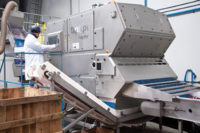The “food supply” is a system of systems, with a complex set of inputs (ingredients) combined over time through precise processes and standards (e.g. cooking temperature, refrigeration/frozen storage temperature, etc.) to form a complex set of outputs. Because this “system of systems” is so complex, there are many places where adulteration (intentional or otherwise) of a food product can occur.
Think of these as vulnerability points, which can occur at any time along the food chain. Adulteration could occur on the farm where perishable fruit or vegetables are harvested or milk is collected. Adulteration could occur during transportation or processing of anything from live chickens or other meat animals to juice-yielding fruit. Opportunities for adulteration even occur in the food distributor’s warehouse or freezer, through the wholesaler to the retailer and the final end use customer. Adulteration can also result from a cyberattack on a company altering temperature-related parameters for cooking or storage.
Food safety remains a prime concern. More recently, however, food defense (the prevention of intentional food adulteration or contamination) has emerged as a concern, as companies deal with the new realities of the Food Safety Modernization Act (FSMA).
Food safety and food defense are opposite sides of the same coin, and adulteration does not have to result from intentionally introducing a pathogen (bioterrorism) or chemical poison into the food supply.
There are two take-homes from this. First, vulnerability points differ depending on the commodity, food product and company involved. Adulteration can occur anywhere in the chain, and a one-size-fits-all food defense plan won’t work. Second, with some exceptions, perishable food products spend more time in transit and in cool or cold storage than they do in the actual processing portion of the chain.
For that reason, dwell time has to be a consideration in developing a food defense plan. The longer a food ingredient or product remains in a fixed location, the more opportunities for that the product to be compromised. Moving targets are always harder for a marksman to hit accurately, and the same is true for food products. Products in transit are more vulnerable when transit pauses or ends.
Companies’ food defense plans have to consider risks in terms of probability. The U.S. government tends to focus on high-impact events like Clostridium botulinum (botulism) toxin being introduced into milk, yet other events that are much lower in potential impact are more likely.
In most cases disgruntled employees are not sophisticated adversaries, capable of complex attacks. Rather, they tend to utilize things readily at hand, like cleaning and industrial chemicals, dirt and plastic. Employees with the motivation to do harm are particularly problematic because they are already inside the system(s), they have knowledge of the system(s) and they have access to material (like industrial chemicals) that would be cause for a recall if introduced to a food product.
A robust food defense plan has to include strategies and tactics to detect the full spectrum of adversaries, from employees who are motivated by criminal intent or revenge and wish to do harm to the company all the way to nation states. In fact, concerns about nation states potentially targeting the U.S. food supply has reemerged in the last several years, after a hiatus that lasted a couple of decades following the disintegration of the former Soviet Union. The U.S. food supply would likely be targeted were the United States to enter a major war with another nation state, so there is no such thing as being too careful.



